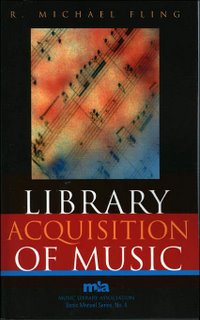
Abstract: R. Michael Fling, Library Acquisition of Music, Music Library Association Basic Manual Series, no. 4 (Lanham, MD: Scarecrow Press; Music Library Association, 2004).

I thought I would start my reviews with a work by my own internship advisor, Michael Fling. He recently retired from his position as collection manager for the music library here at Indiana University. As a capstone to a long and distinguished career, this tome serves to impart some of his expertise to the music library world.
Library Acquisition of Music gives a basic overview of some considerations that must be made for searching and ordering music scores and sound recordings in particular. These two formats pose difficulties for acquisitions staff not experienced in music terminology and particularities of publishing practices in these two mediums. For example, music scores often do not carry ISBNs, the nearly ubiquitous numbering system found on most mass-marketed books. Rather, each publisher has its own unique numbering system, which helps distinguish one publication in the publisher's catalog from other works. This becomes a difficult realm to navigate when one publisher could publish multiple versions of the same work in different score formats, including study scores, piano reductions, performance scores and parts, critical editions, etc., often with almost identical publishers numbers. Compound these nuances with the prevalence of foreign language imprints, each using their own language (sometimes non-Roman language such as Russian or Greek) to describe the type of score. Then, vendor catalogs, often omit critical information about a score that distinguishes it from another. Then, multiple reprints of public domain works by different publishers confounds the process of selecting the proper work further.
Clearly, the selection of materials for libraries requires a music expert, capable of understanding the various needs of music library patrons, the ins and outs of over 1000 years of music history, the frustrations and particularities of music publishing and distribution practices, as well as the skill to communicate with various music vendors and responsibly manage significant resources in library budgets. The book helps identify areas of trouble for music acquisitions personnel to look out for. He also provides a number of resources for locating music materials, including specialized music genres such as Jazz, microforms, used and antiquarian items, and dissertations.

0 Comments:
Post a Comment
Subscribe to Post Comments [Atom]
<< Home